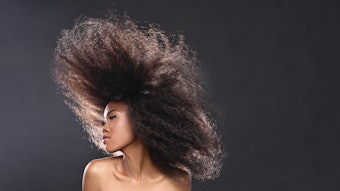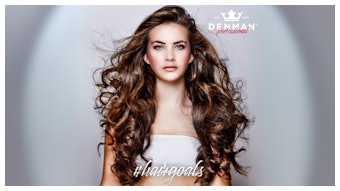
It is hard to be in the salon industry without knowing Allen Ruiz (@allenruizstyle).
Either your paths have crossed in one of his classes, you have seen his work on designer runways or in fashion magazines or you have read about his multiple winning styles for the North American Hairstyling Awards, most recently bringing home Master Stylist of the Year 2023.
Ruiz has been in the salon industry for decades, including over 20 years of education with Aveda and having opened Ruiz Salon with his co-owner in 1998. Although he is currently global style director of Aveda North America, a successful salon owner and an award-winning stylist with more accolades than you can count, it has taken grit and determination to get here. Ruiz himself will tell you this is what he always knew he wanted to do, so he dreamed big and worked hard. He sat down with Beauty Launchpad, so we could learn how it all started, where he gets his inspiration and his greatest tips for success.
Beauty Launchpad (BLP): How did you get started in the salon industry?
Allen Ruiz (AR): Hairdressing is something I always wanted to do since I was a kid. I used to love to style my sister’s Barbie doll’s hair. I remember watching a talk show segment with a celebrity hairdresser doing a before and after makeover. Watching that stylist so effortlessly transform their model’s appearance and seeing that immediate change in the model’s confidence and mood really appealed to me. At that moment, I knew I wanted to do hair, so I could make people look and feel good. Growing up in the 80s, I would cut all of my friend’s hair. I did a ton of scatter undercuts and undercut bobs during that time and loved every minute of it. I knew this was my passion and what I wanted to do.
BLP: What is your inspiration process like? How do you get inspiration for your creations?
AR: I draw a lot of creative inspiration from fashion and pop culture (movies, music, celebrity, etc.) as well as my travels. My inspiration “process” starts with gathering images I love. Once upon a time, I used to pull inspiration pics from magazines, and now it’s all digital. I start by uploading all of the inspiring photos I find into a folder. Then, I separate the folder into what I liked about a particular image. I categorize by photography, video, lighting, wardrobe, cut, style, texture, model, etc. Then, I start to storyboard until I have the vision for my new collection.
BLP: Tell us about your journey in the industry? What led you here?  Allen Ruiz is the NAHA 2023 Master Stylist of the Year
Allen Ruiz is the NAHA 2023 Master Stylist of the Year
AR: My passion for hair and fashion and eagerness and drive to learn really helped get me to where I am today. My mantra is ‘what you put into this business is what you will get out of it.’ The best educators out there are the ones that know this truth and make themselves accessible and are willing to share anything and everything just to help someone else be successful. By giving it your all and being willing to invest in others, it truly helps you grow as an artist.
I started my career with Aveda back in 2000 as an educator and then guest artist. Being able to influence imagery on fashion and education fronts for such an amazing brand has truly been one of the most rewarding experiences of my career.
Another career-defining moment was when I made the decision to enter NAHA for the first time in 2007 and ended up winning. I had been attending a lot of the major hair shows and getting to meet the award-winning hairdressers, which made me aspire to be like them. Early Douglass, Antoinette Beenders and so many others influenced and inspired me. Being around these amazing artists and wanting to be like them definitely helped get me to where I am today.
BLP: What do you consider your specialty and why?
AR: I think my vision and the ability to execute is my biggest strength. I am always able to see the big picture and have the attention to detail to deliver it.
BLP: What advice would you give stylists just entering the industry?
AR: Dream BIG and work HARD. What you put into this business is exactly what you will get out of it. Work on hair as much as possible. Whether it’s assisting on set or working behind the chair, the more you do and see, the better and more confident you will become, and that truly is what makes a successful hairdresser. Having the confidence in yourself and abilities to know you do great work.
BLP: If you could go back in your journey and do anything over again, would you?
AR: Starting out, we didn’t have the internet or other means to connect and forge relationships and find inspiration as easily as we do today. If I knew back then getting started, what I’ve learned along the way, I would have dreamed bigger for sure. It’s so easy nowadays to slip into someone’s DMs and say, ‘Hey, can I bring you in for a class?’ “Can we collaborate on something?” etc. That did not exist back in the day!
BLP: What challenges have you encountered in the salon industry over the years?
AR: I think the biggest challenge is finding people you want to ‘play’ with, meaning peers who love doing what you do as much as you do. Another challenge is that the work force keeps changing in this ‘insta’ world we live in, and it’s very rare to find someone that actually wants to put in the work. COVID times and shutdowns were definitely challenging, and we’re still all recovering from those dark days.
BLP: Where do you see the salon industry headed?
AR: I think it’s been a struggle getting people out of habits that were formed during COVID…getting them out of their house again. People started going longer between cuts and colors and a lot are continuing to do that now. People still aren’t 100% back at work and, therefore, are less focused on their appearance, not having to interact regularly with co-workers and clients in person. We’ll get there, but it will take some more time. With a lot of hairdressers not wanting to come back to work, I think we’ll continue to see a lot of stylists working out of their homes, becoming app based and willing to go to client’s homes. What that means for the industry…that flexibility and the automation of many other jobs will likely lead to more people pursuing a career in beauty, which is going to be great for our industry which is here to stay.
Allen’s 5 Salon Must Haves
- My business and life partner Heath Smith, who manages the operations and day to day of the business, is a rockstar.
- Our amazing guests bring me joy and reinforce my decision to be a hairdresser every day.
- My team inspires me to be a better person and to strive to improve my craft on a daily basis.
- My Aveda distributor Neill Corporation is supportive and partners in helping grow our business. They have been key to our success.
- The city of Austin has the coolest people and vibe. The outpouring of support from the community after this latest NAHA win has truly been amazing!
How-To: Bixie (Bob/Pixie)
 Learn how to create the bixie cut featured on Beauty Launchpad's July/August 2023 cover.Image Credits: Cut: Allen Ruiz; Color: Luis Gonzalez; Photography: Lauren Krysti; Make-up: Zui Peter Phung
Learn how to create the bixie cut featured on Beauty Launchpad's July/August 2023 cover.Image Credits: Cut: Allen Ruiz; Color: Luis Gonzalez; Photography: Lauren Krysti; Make-up: Zui Peter Phung
- To remove bulk from the nape of the neck, create two diagonal forward sections from occipital to the middle of the ear. Starting out with a 1” section, you’re going to create graduation by point cutting. Pivot from your first section, and re-direct to the previous one as you continue to point cut. Now, you start working your outline.
- Take a diagonal back section parallel to the hair line, starting 1” away from the hairline, to create your outline. Continue sectioning till you run out of hair to cut.
- Once you cross the center of the head, your sections will now become diagonal forwards. Continue to create your “bob” shape perimeter. Once you’ve established your “bob” perimeter shape, check for balance throughout.
- Now, we want to layer the cut. Take a section from the center of the head pulled out to 90 degrees, cutting from short to long using point cutting technique, to establish the length you want for the interior of the hair cut. Continue to take pie-shaped sub-sections following your guide, pivoting around the head and cutting short to long. Continue this same technique all the way around the head.
- When finished, wrap dry the hair with a paddle brush for a smooth finish.
- Personalize the fringe by slide cutting through it, taking the weight out as you go. Go back in with large texturizing shears to remove more weight and create more texture and movement.














